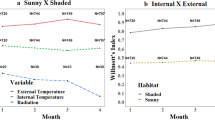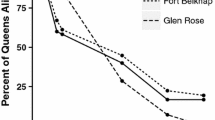Abstract
Nest foundation in the leaf-cutting ant Atta sexdens is claustral, and the single queen completely relies on its body reserves throughout, approximately, 9 weeks until the first workers emerge and initiate foraging. Nest digging is much time- and energy-consuming, and it is an open question how queens decide on the length of the tunnel they dig and therefore the depth of the initial chamber. Shallow founding nests may be energetically cheaper to dig, but queens may be more exposed to changing environmental variables. Deeper nests, on the other hand, may be climatically more stable and suitable, but more expensive to dig. We hypothesized that the maximal nest depth excavated by Atta founding queens may represent the outcome of an evolutionary trade-off between maximizing nest depth and minimizing energy expenditure during digging, so as to save energy for the long claustral phase. We tested this hypothesis by comparing the fitness consequences of increased digging effort in queens that were experimentally stimulated to excavate a complete founding nest either once, twice or three times consecutively compared to control queens that did not dig. Fitness was quantified as mortality rates, rates of egg-laying and offspring production, and size of the fungus garden until the emergence of the first workers. Results showed that, in contrast with the initial expectations, fungus growth, egg-laying rates and offspring production were not affected by the increased digging effort in the experimentally induced successive excavations. However, a significant higher mortality was observed in queens with increased digging effort, i.e., those that dug two or three nests consecutively. It is argued that in queens a behavioral mechanism for the control of nest depth has evolutionary been selected for as a trade-off between maximizing nest depth, to favor protection of the queen against unsuitable environmental variables, and minimizing energy expenditure during digging, which significantly affects survival.



Similar content being viewed by others
References
Autuori M. 1942. Contribuição para o conhecimento da saúva (Atta spp.—Hymenoptera—Formicidae). II. O sauveiro inicial (Atta sexdens rubropilosa, Forel, 1908). Arq. Inst. Biol. 13: 67–86
Boomsma J.J. and Isaaks J.A. 1985. Energy investment and respiration in queens and males of Lasius niger (Hymenoptera: Formicidae). Behav. Ecol. Sociobiol. 18: 19–27
Brown M.J.F. and Bonhoeffer S. 2003. On the evolution of claustral colony founding in ants. Evol. Ecol. Res. 5: 305–313
Cunha W.H.A. 1968. Observações acêrca do comportamento da iça—Atta sexdens rubropilosa Forel, 1908—Hymenoptera—Formicidae—na fundação do formigueiro. Ciência e Cultura 20: 233–234
Della Lucia T.M.C., Moreira D.D.O., Oliveira M.A. and Araújo M.S. 1995. Perdas de peso de rainhas de Atta durante a fundação e o establecimento das colônias. Rev. Bras. Biol. 55: 533–536
Della Lucia T.M.C., Vilela E.F., Moreira D.D.O., Bento J.M.S. and Dos Anjos N. 1990. Egg-laying in Atta sexdens rubropilosa, under laboratory conditions. In: Applied Myrmecology—A World Perspective (Vander Meer R.K. and Jaffé K., Eds), Westview Press, Boulder. pp 173–179
Eidmann H. 1935. Zur Kenntnis der Blattschneiderameise Atta sexdens L., insbesondere ihrer Ökologie. Z. angew. Entomol. 22: 185–436
Hölldobler B. and Wilson E.O. 1990. The Ants. Harvard University Press, Cambridge. 732 pp
Johnson R.A. 2000. Water loss in desert ants: caste variation and the effect of cuticle abrasion. Physiol. Entomol. 25: 48–53
Johnson R.A. and Gibbs A.G. 2004. Effect of mating stage on water balance, cuticular hydrocarbons and metabolism in the desert harvester ant, Pogonomyrmex barbatus. J. Insect Physiol. 50: 943–953
Keller L. and Passera L. 1989. Size and fat content of gynes in relation to the mode of colony founding in ants (Hymenoptera; Formicidae). Oecologia 80: 236–240
Magwere T., Pamplona R., Miwa S., Martinez-Diaz P., Portero-Otin M., Brand M.D. and Partridge L. 2006. Flight activity, mortality rates, and lipoxidative damage in Drosophila. J. Gerontol.: Biol. Sci. 61A: 136–145
Pereira-Da-Silva, V. 1979. Dinâmica populacional, biomassa e estrutura dos ninhos iniciais de Atta capiguara Gonçalves, 1944 (Hymenoptera: Formicidae) na região de Botucatu, SP. Thesis Livre Docencia, UNESP, Botucatu, Brazil, 98 pp
Ribeiro F.J.L. 1972. Um estudo sobre o comportamento da fêmea durante a fundação da colônia em Atta sexdens rubropilosa Forel, 1908 (Hymenoptera—Formicidae). Tese Doutoramento, Universidade São Paulo, Psicologia
Ribeiro F.J.L. 1995. A escavação do solo pela fêmea da saúva (Atta sexdens rubropilosa). Psicologia USP 6: 75–93
Seal J.N. 2009. Scaling of body weight and fat content in fungus-gardening ant queens: does this explain why leaf-cutting ants found claustrally? Insect. Soc. 56: 135–141
Seal J.N. and Tschinkel W.R. 2007. Energetics of newly-mated queens and colony founding in the fungus-gardening ants Cyphomyrmex rimosus and Trachymyrmex septentrionalis (Hymenoptera: Formicidae). Physiol. Entomol. 32: 8–15
Sohal R.S. and Buchan P.B. 1981. Relationship between physical activity and life span in the adult housefly, Musca domestica. Exp. Gerontol. 16: 157–162
Weber N.A. 1972. Gardening Ants - The Attines. Philadelphia, The American Philosophical Society, 146 pp
Acknowledgments
FR dedicates this work to Martin Bollazzi, who shared all phases of euphoria and hopelessness of the queen project over the years. The authors are indebted to Kerstin Fröhle for inspiring work on Atta vollenweideri queens, to Liciana Vaz de Arruda Silveira, Carlos Matos and Christian Jost for help with statistical analyses, to Nelson Carneiro, Antonio Marcos de Lima and Donizete de Almeida for soil collection and help with the preparation of the experimental tubes, and to two anonymous reviewers for helpful comments. This study was performed in the framework of the co-operation agreement between the UNESP-Botucatu and the University of Würzburg (Ref. 910-2007). Thanks are also due to The São Paulo State Research Foundation (FAPESP) for the post-doctoral scholarship to the first author (2007/04010-0) and for a research aid (2007/07091-0). FR was supported by funds from the Deutsche Forschungsgemeinschaft (DFG, grant SFB 554/TP E1) and FAPESP (2008/05434-0).
Author information
Authors and Affiliations
Corresponding author
Rights and permissions
About this article
Cite this article
Camargo, R.S., Forti, L.C., Fujihara, R.T. et al. Digging effort in leaf-cutting ant queens (Atta sexdens rubropilosa) and its effects on survival and colony growth during the claustral phase. Insect. Soc. 58, 17–22 (2011). https://doi.org/10.1007/s00040-010-0110-5
Received:
Revised:
Accepted:
Published:
Issue Date:
DOI: https://doi.org/10.1007/s00040-010-0110-5




